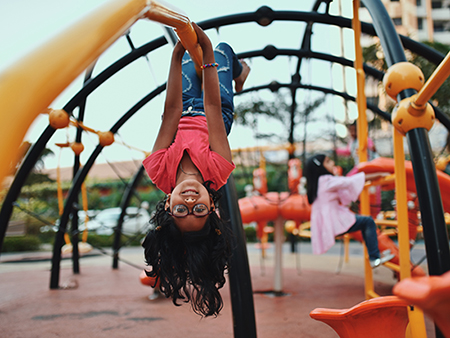Editor's Note: The information published in this story is accurate at the time of publication. Always refer to uab.edu/uabunited for UAB's current guidelines and recommendations relating to COVID-19.
 UAB expert Samisksha Raut, Ph.D., explains the importance of keeping kids away from playgrounds and from touching various toys and sports equipment during the COVID-19 pandemic quarantine.With the local and regional quarantine instructions asking people to stay home and avoid contact with others, it has been a significantly stressful and uncertain time for everyone — including children.
UAB expert Samisksha Raut, Ph.D., explains the importance of keeping kids away from playgrounds and from touching various toys and sports equipment during the COVID-19 pandemic quarantine.With the local and regional quarantine instructions asking people to stay home and avoid contact with others, it has been a significantly stressful and uncertain time for everyone — including children.
Although everyone has been instructed to stay home, many parents are finding it hard to keep their kids active and are still allowing them to play outside on playgrounds with other kids, toys and sporting equipment. The question they ask: What could be the harm in that if they are following the appropriate social distancing orders?
According to the Centers for Disease Control and Prevention, the key to slowing down the spread of COVID-19 is to limit contact as much as possible. If children meet outside in large groups, it can put everyone at risk.
Even if kids are still social-distancing on the playground, they are still touching the same surfaces as all the other kids. COVID-19 is known to live on surfaces from a few hours to days.
| Get the latest COVID-19 information at uab.edu/coronavirus. |
Here is how long COVID-19 can stick around on surfaces, according to a new study from the New England Journal of Medicine:
- On plastic: After eight hours, only 10 percent of the virus was still there, but it did not become undetectable until after 72 hours.
- On stainless steel: The numbers began plummeting after just four hours, becoming undetectable after about 48 hours.
- On copper: Undetectable after eight hours.
- On cardboard: Undetectable after 48 hours.
 Samiksha Raut, Ph.D.The University of Alabama at Birmingham’s expert, Samiksha Raut, Ph.D., associate professor in the Department of Biology, says it is important for parents to keep their kids at home and away from playgrounds and shared toys and sports equipment during this time.
Samiksha Raut, Ph.D.The University of Alabama at Birmingham’s expert, Samiksha Raut, Ph.D., associate professor in the Department of Biology, says it is important for parents to keep their kids at home and away from playgrounds and shared toys and sports equipment during this time.
“Kids are constantly moving from one part of the playground to another and are quite prone to touching their faces — nose, eyes, etc. at intervals,” Raut said. “Therefore, if they happen to touch an object with the novel coronavirus, the chances of getting infected are very high. Despite the emerging evidence that children continue to show mild symptoms of COVID-19, they can still function as active carriers of the virus, especially in the asymptomatic phase. Above all, given their ages they do not understand the importance of social distancing and, hence, should be actively supervised by parents and/or caretakers.”
To help minimize the community impact of the COVID-19 spread, use these hygiene guidelines recommended by CDC for your kids:
- Make sure the children wash their hands with soap and water for at least 20 seconds or with an alcohol-based sanitizer.
- Keep children quarantined from a family member who is sick with the virus.
- Periodically clean and disinfect the high-touch surface areas like table-tops, chairs, remote controls, doorknobs, toilets and light switches.
- Wash plush toys and stuffed animals in the washing machine by following instructions. Wash their clothes separately from the clothes of a family member who is under quarantine period.
Get the latest COVID-19 information at uab.edu/coronavirus.